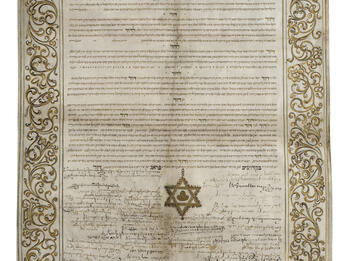Kiddushin and Wedding Ceremony
Between 1723 and 1737, illustrator Bernard Picart partnered with the Dutch bookseller, editor, and publisher Jean-Frédéric Bernard on Cérémonies et coutumes religieuses de tous les peuples du monde (Religious Ceremonies and Customs of All the Peoples of the World). It was the most famous encyclopedic work on religion of its time, and is considered the first global, comparative vision of religion. It was condemned by the Catholic Church but was a success with the public and translated immediately into Dutch, and later into English and German. It was reprinted many times. The book’s 266 plates by Picart included depictions of Jewish religious practices in Amsterdam, focusing on the wealthy Sephardic community. Here, two rituals related to marriage are depicted: (top) the groom breaking the glass in the wedding ceremony and (bottom) kiddushin, the betrothal ceremony, where the groom gives the bride an object of value (here, a ring).
Credits
Bernard Picart (workshop of), Huwelijksplechtigheid bij Portugese en Asjkenazische Joden Ceremonie nuptiale des Juifs Portugais / Ceremonie nuptiale des Juifs, Amsterdam, 1723. Allemands. Rijksmuseum, Amsterdam.
Published in: The Posen Library of Jewish Culture and Civilization, vol. 5.





